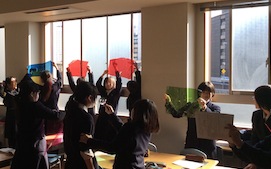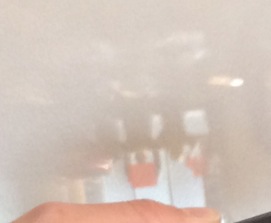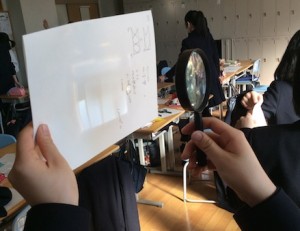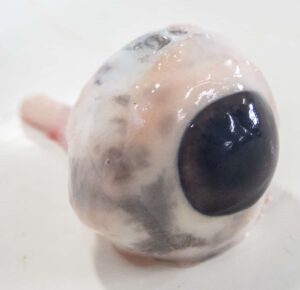Easy Home Science! Project an “Upside-Down World” on Your Wall — The Magic of Lenses and Light
I’m Ken Kuwako, a Science Trainer. Every Day is an Experiment.
Do you remember that classic science class experiment using a candle, a magnifying glass, and a screen? In the dark room, when the upside-down image of the candle flickered onto the screen—a bit blurry, yet clearly there—didn’t you feel a little spark of excitement?
But here’s a question that often pops up: “Why is it always a candle?”
Maybe that experiment led you to believe, “You can only project things that glow on their own, like a candle or a light bulb.” “So, you can’t project that pencil on your desk or the blue sky outside the window?”… Wrong! Not at all!
The truth is, a magnifying glass (a convex lens) has the power to project anything that our eyes can see. That’s because everything we look at is reflecting light. The lens simply gathers that reflected light.
Today, I’m going to share a beautiful and very easy experiment that proves this point. We won’t be using any candle flames. Instead, we’ll use the view outside your window!
The Science Recipe
What you need: Colored cellophane, a magnifying glass (you can often buy one at a dollar store/100-yen shop)
How to experiment:
① It’s best to do this during the day. Turn off the lights in the room and have someone hold the colored cellophane near the window.
② Take the magnifying glass and move toward a wall opposite the window.
③ Hold the magnifying glass close to the wall and move it back and forth.
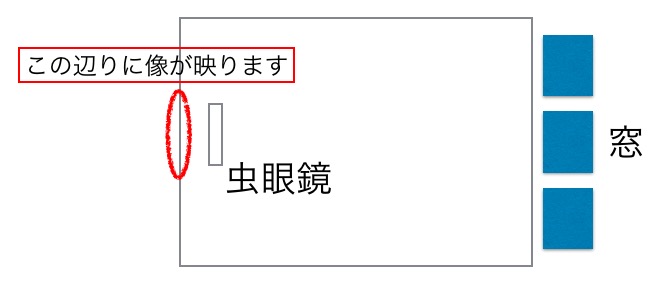
Result:
What do you see? When you do this, a clear image of the window view appears, just like in the photo below.
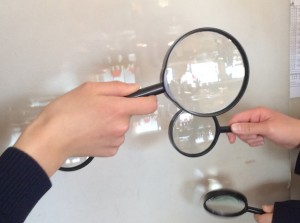
You get an image for every magnifying glass! Isn’t that neat? If you zoom in, you can see…
Do you notice it? The person holding the cellophane is projected upside down! The entire scene is projected, too.
Why is the image upside down? It’s the exact same principle as the candle experiment. The view outside the window and the cellophane reflect sunlight. That light refracts (bends) as it passes through the magnifying glass (a convex lens). After passing through the lens, the light rays converge at a single point (they come into focus). This image, which is formed where the light actually gathers, is called a Real Image (jitsuzou in Japanese) in science. A Real Image can be clearly projected onto a screen or a wall, and it always has the property of being inverted (upside down and flipped horizontally).
The image you see reflected on the magnifying glass itself is NOT upside down! Only the image created by the light passing THROUGH the lens is inverted.
This is a wonderful observation! The reflection you see on the glass surface of the magnifying glass is just like a mirror, unrelated to the lens’s power of refraction. But the Real Image, formed by the light that passes through the lens, is inverted. This is the very proof of how a lens works!
The Same Mechanism as Your Eye and a Camera!
In fact, this experiment uses the exact same principle as a camera. The magnifying glass is the “lens,” and the wall acts as the “film” or “image sensor.” Even more surprisingly, our own eyes use this same mechanism to see the world. The lens in our eye, called the crystalline lens, projects an inverted Real Image of the scene onto the retina, the screen at the back of the eye.
“Wait, then why don’t we see the world upside down?” you might ask. That’s because our brain instantly flips the inverted image from the retina, correcting it to the “proper orientation.” Our bodies are truly amazing!
You can do this experiment without cellophane, but seeing the beautiful colors projected makes the experience much more impressive. Also, when I ran this experiment, one student did something very clever, which I’d like to share. They projected the image onto a sheet of paper:
This is a great way to project a clear image even if you don’t have a white wall. I hadn’t thought of that myself—students are incredible! I highly recommend trying this at home.
Tips for Demonstrating This in Class!
Finally, here are a few tips for demonstrating this kind of experiment in a classroom setting. The two main keys are:
Ensure every student gets to handle some of the equipment.
Ensure every student is actively participating.
For example, with a class of 40 students, you could provide 20 magnifying glasses. Distribute those to half the students, and have the other half stand by the window holding the cellophane and moving it around. By doing this, every student is involved in some activity. This makes the lesson much more effective, so I recommend it. Especially in the field of light and optics, it’s great to use a variety of hands-on demonstrations to move the lesson forward!
Contact and Requests
Bring the wonder and excitement of science closer to you! I’ve put together easy-to-understand tips and fun science experiments you can do at home. Feel free to search around!
The content of the Science Idea Notebook has been published as a book. Details are here
About the administrator, Ken Kuwako: here
For various requests (writing, lectures, science classes, TV supervision/appearances, etc.): here ・Updates on articles are posted on X!
![]() Experimental videos are available on the Kagaku no Neta Channel!
Experimental videos are available on the Kagaku no Neta Channel!


